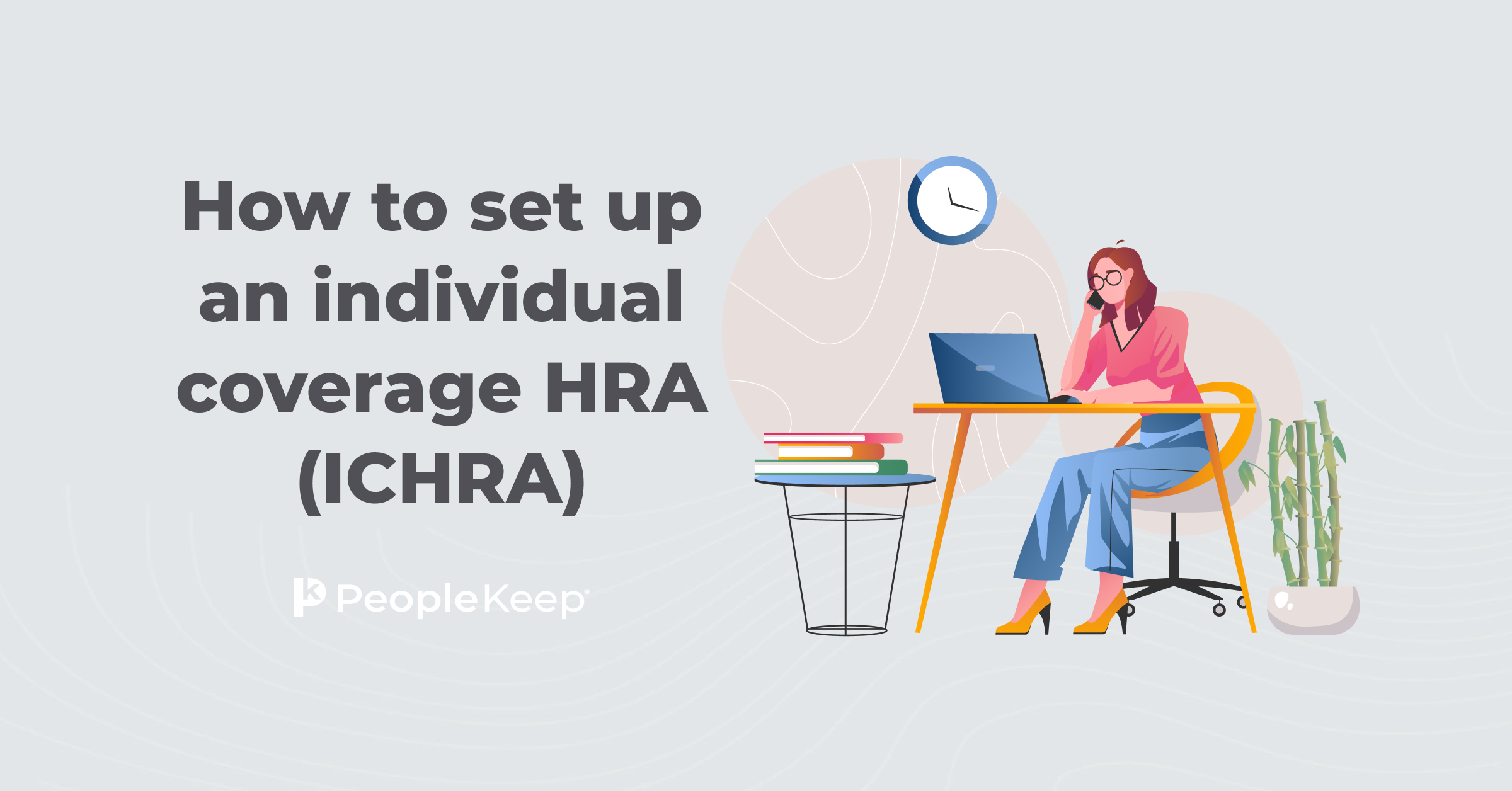5 steps to a successful ICHRA launch
By Holly Bengfort on November 26, 2024 at 11:15 AM
The individual coverage health reimbursement arrangement (ICHRA) is a flexible and innovative way for employers to offer health benefits to their employees. However, a successful ICHRA launch requires careful execution. By steering clear of common mistakes and following best practices, you can successfully introduce this modern health benefit to your employees.
In this article, we’ll break down five key steps to follow when launching your ICHRA to ensure it hits the mark for employees while setting your organization up for success.
In this blog post, you'll learn the following:
- What sets the ICHRA apart from a traditional group plan.
- How you can customize allowance amounts using employee classes.
- The importance of informing your employees about their new type of health plan coverage.
What is an ICHRA?
The ICHRA is an alternative to a traditional group health plan. It's a health benefit that allows employers to reimburse employees for their individual health insurance premiums instead of buying a one-size-fits-all plan for them.
With an ICHRA, you can reimburse employees tax-free for more than 200 types of eligible medical expenses. Plus, there are no minimum or maximum reimbursement limits with an ICHRA. This means you can offer your employees as much money as you'd like in contributions.
Here's how the ICHRA works:
- You set a monthly allowance amount for your employees.
- Your employees purchase qualifying individual health insurance coverage and address other healthcare needs using their own money.
- Employees submit proof of their healthcare costs to you or your HRA administrator for reimbursement.
- Once you approve the eligible expense, your employees receive tax-free reimbursements up to their allowance amount.
ICHRAs are also great solutions for applicable large employers (ALEs) striving to meet the Affordable Care Act’s (ACA) employer mandate. An ICHRA keeps your costs predictable and helps you avoid costly group health insurance and annual premium hikes while providing valuable health benefits to your employees.
Maximizing your ICHRA benefit
According to our 2024 Employee Benefits Survey, 92% of employees rated health benefits as important. This makes the ICHRA a potentially effective tool for recruitment and retention at your organization. But If you want to get the most out of your ICHRA, you have to make sure you and your employees use it to its fullest potential.
Here are five steps you can follow to maximize your ICHRA benefit:
Step 1: Familiarize yourself with ICHRA rules and regulations
Understanding the ins and outs of this benefit is important if you want to launch your ICHRA successfully.
The IRS has clear guidelines regarding:
- Eligible employees. The ICHRA can only cover W-2 employees. Your W-2 workers must also have a qualifying form of individual health insurance coverage to take part in the benefit. Uninsured employees and those on traditional group plans, like a spouse’s or parent’s, can't use an ICHRA.
- Eligible expenses. Eligible expenses include those in IRS Publication 502, though employers can restrict items. For example, if you only want to reimburse premiums, you can provide a premium-only ICHRA. Otherwise, you can reimburse your employees for several types of out-of-pocket medical costs.
- Reporting requirements and legal plan documents. Employers must report the benefit on employees’ W-2s to comply with IRS rules. You also need to know which legal documents, such as plan documents and summary plan descriptions, the federal government requires.
- Premium tax credit coordination. ICHRA has premium tax credit restrictions. Employees participating in the ICHRA can't receive these credits. They can opt out and collect their credits if their allowance is deemed “unaffordable.”
Familiarizing yourself with these rules can help you avoid compliance issues down the line. Using PeopleKeep's ICHRA administration software can help you better understand and follow these rules. Our platform automatically generates legal plan documents. Plus, our team reviews your employees’ reimbursement requests for you. This ensures you’re only reimbursing them for eligible expenses.
Step 2: Design your ICHRA benefit
You should tailor your ICHRA to meet the specific needs of your workforce. Consider factors such as your budget and employee demographics. From there, you can decide on things like contribution amounts and eligibility requirements.
The ICHRA is flexible. Here are some elements you can customize to make it a perfect fit for your organization:
- Classes. With the ICHRA, you can vary allowances and benefit eligibility with 11 employee classes, such as full-time employees or part-time employees. This allows you to customize allowances for employees in different states, for example.
- Allowances. Instead of paying a percentage of premiums as you do with a group health insurance plan, the ICHRA lets you specify dollar amounts that you reimburse employees up to for eligible expenses. You can customize these amounts for each class of employee, such as seasonal employees or temporary employees. Or you can standardize allowances to keep things simple.
- Eligible expenses. Decide if you want to reimburse employees for individual plan premiums only or their out-of-pocket costs as well.
- Waiting periods. You can determine whether you’d like new hires to become eligible for the benefit immediately or have to wait up to 90 days before becoming eligible.
Step 3: Educate your employees on ICHRA
Once you set your objectives and design the benefit, it's crucial to communicate the benefits and details of the ICHRA to your employees. This is necessary since most employees are accustomed to traditional group health insurance.
According to KFF1, more than 60% of Americans younger than 65 had employment-sponsored health insurance in 2023. This means your employees may be in unfamiliar territory with your new health benefit. They may not know how the ICHRA special enrollment period works, or how to shop for an individual health plan.
To make the transition easier, you can offer educational materials, host informational sessions, and provide answers to common questions. This helps employees understand how the ICHRA works, what it covers, and how it can benefit them. You’ll also need to notify employees about the benefit before it begins. The federal government recommends providing 90 days' notice.
This is another situation where PeopleKeep can help you out. With our ICHRA administration software, your employees can shop for individual health plans directly from their PeopleKeep account. Our seamless shopping experience helps them find the ideal health coverage that's tailored to their specific needs. We also send email notifications to employees 30 days before your benefit starts.
Step 4: Maintain accurate records
Keeping precise and comprehensive records is critical for successfully managing an ICHRA.
To guarantee compliance with IRS regulations, you should document all:
- Contributions
- Reimbursements
- Eligible expense
Maintaining detailed records will streamline the reporting process for the benefit and simplify any required adjustments.
Step 5: Monitor and adjust as necessary
The setup process shouldn’t be the only occasion where you take a deep dive into your new health benefit. After launching the ICHRA, you should monitor participation rates, employee feedback, and cost-effectiveness.
Gathering data on usage and satisfaction is important to identify potential areas for improvement. From there, you can make adjustments to enhance the program and address any concerns raised by your employees.
ICHRA vs group health insurance
Offering an ICHRA presents numerous advantages compared to a traditional group health plan.
Here are just a few to consider:
- Cost. Employers set allowance amounts, and their contributions are tax-deductible. Plus, you won’t need to stress about yearly premium increases or unexpected costs tied to high claim volume from your workforce.
- Customization. Not only do you get to set your own monthly allowance, but you can customize it using employee classes.
- Employee empowerment. An ICHRA gives employees more control over their healthcare. When you offer an ICHRA, they get to choose individual plans that match their needs.
- Healthcare savings. ICHRA allowances don't count as taxable income on your employees' W-2s. Your eligible employees receive tax-free reimbursements when they incur eligible out-of-pocket expenses.
Is the QSEHRA a better option?
There’s another way to reimburse employees for individual health insurance premiums.
While the ICHRA works for employers of all sizes, the qualified small employer HRA (QSEHRA) is only for those with fewer than 50 full-time equivalent employees (FTEs).
Unlike an ICHRA, the QSEHRA extends eligibility to employees who aren’t covered by an individual health insurance plan. With the QSEHRA, employees only need health plans that provide minimum essential coverage (MEC). So, if you have several employees covered by a spouse's or parent's plan, they can still participate in the QSEHRA.
As with the ICHRA, the QSEHRA allows you to reimburse your eligible employees tax-free for their individual insurance premiums and other qualifying medical expenses. So, you can still reimburse your employees for the health insurance coverage they choose instead of buying it for them.
Unlike the ICHRA, the IRS sets annual contribution limits with a QSEHRA. And, while there are no employee classes, you can still customize monthly allowances based on employee age and family status.
Conclusion
The individual coverage HRA (ICHRA) is a game-changing option for many business owners and employers who want to save money while still doing right by their employees. Embracing the ICHRA empowers you to meet the diverse needs of your workforce without the high cost of a traditional group health plan.
As with any health benefit, launching an ICHRA requires careful planning. By following our step-by-step guide, you can navigate your new benefit with ease. However, if you'd like some help, you can use PeopleKeep as your plan administrator to save you valuable time and money.
This blog article was originally published on September 21, 2020. It was last updated on November 26, 2024.
Check out more resources
See these related articles

Who is eligible for the individual coverage HRA (ICHRA)?
Find out who qualifies for the Individual Coverage HRA (ICHRA). Explore ICHRA eligibility rules and how they benefit both employers and employees.

How the ICHRA is changing healthcare
Learn how the ICHRA is transforming healthcare by offering flexible, personalized health benefits for businesses and employees alike.

How to set up an individual coverage HRA (ICHRA)
Ready to offer ICHRA? Follow this guide to learn how to set up an Individual Coverage HRA, from plan design to compliance and employee communication.



